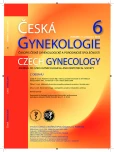The new technologies for the analytical examination of the embryonic metabolome and its prospects
Authors:
I. Crha 1
; A. Mádr 2; J. Musilová 2; Z. Glatz 2; J. Žáková 1; P. Ventruba 1
Authors‘ workplace:
Gynekologicko-porodnická klinika LF MU a FN Brno, přednosta prof. MUDr. P. Ventruba, DrSc., MBA
1; Ústav biochemie, Přírodovědecká fakulta a CEITEC, Masarykova univerzita, Brno, vedoucí prof. RNDr. Z. Glatz, CSc.
2
Published in:
Ceska Gynekol 2012; 77(6): 502-506
Overview
Objective:
To review current technologies for the analytical examination of the embryonic metabolome and its perspectives.
Design:
Review article.
Setting:
Department of Gynecology and Obstetrics, Faculty of Medicine, Masaryk University, and University Hospital, Brno, Department of Biochemistry, Faculty of Science and CEITEC, Masaryk University, Brno.
Methods and results:
Nowadays, very sensitive analytical technologies are available. They enable exact measurement of various molecules – products of embryo metabolism during first days of cultivation. The capillary electrophoresis is one of promising method. Recent studies analysed metabolic differences between embryos that result in a pregnancy and those that do not. Amino acid levels, glucose or pyruvate in the embryo culture media were analysed most frequently. However, results of these studies are ambiguous.
Conclusions:
The capillary electrophoresis with contactless conductivity detection may provide a useful data of the embryonic metabolome. A comprehensive analysis of the used culture medium may represent a valuable adjunct to morphological criteria for enhanced rates of implantation and delivery.
Key words:
metabolomics, metabolome analysis, capillary electrophoresis, embryo, assisted reproductive techniques.
Sources
1. Botros, L., Sakkas, D., Seli, E. Metabolomics and its application for non-invasive embryo assessment in IVF. Mol Hum Reprod, 2008, 14, 12, p. 679–690.
2. Coufal, P., Zuska, J., van de Goor, T., et al. Separation of twenty underivatized essential amino acids by capillary zone electrophoresis with contactless conductivity detection. Electrophoresis, 2003, 24, p. 671–677.
3. Crha, I., Konečná, H., Žáková, J., et al. Proteom seminální plazmy u mužů s azoospermií. Prakt Gyn, 2011, 15, 2, s. 2–5.
4. Dunn, WB. Current trends and future requirements for the mass spectrometric investigation of microbial, mammalian and plant metabolomes. Phys Biol, 2008, 5, p. 1–24.
5. Fiehn, O. Metabolomics – the link between genotypes and phenotypes. Plant Mol Biol, 2002, 48, p. 155–171.
6. Hardarson, T., Ahlström, T., Rogberg, L., et al. Non-invasive metabolomic profiling of day 2 and 5 embryo culture medium: a prospective randomized trial. Hum Reprod, 2011, 27, p. 89–96.
7. Harper, JC., Wilton, L., Traeger-Synodinos, J., et al. The ESHRE PGD Consortium: 10 years of data collection. Hum Reprod Update, 2012, 18, 3, p. 234–247.
8. Hlinka, D., Lazarovská, S., Rutarová, J., et al. Non-invasive monitoring of the timing of early embryo cleavages-objectively measurable predictor of human embryo viability. Čes Gynek, 2012, 77, 1, s. 52–57.
9. Katz-Jaffe, MG., Schoolcraft, WB., Gardner, DK. Analysis of protein expression (secretome) by human and mouse preimplantation embryos. Fertil Steril, 2006, 86, p. 678–685.
10. Mastenbroek, S., Twisk, M., van der Veen, F., Repping, S. Preimplantation genetic screening: a systematic review and meta-analysis of RCTs. Hum Reprod Update, 2011, 17, 4, p. 454–466.
11. Musilová, J., Sedláček, V., Kučera, I., Glatz, Z. Capillary zone electrophoresis with field enhanced sample stacking as a tool for targeted metabolome analysis of adenine nucleotides and coenzymes in Paracoccus denitrificans. J Sep Sci, 2009, 32, p. 2416–2420.
12. Opekar, F., Štulík, K. Elektrochemická detekce s elektrodami mimo roztok – znovuzrození bezkontaktních impedančních metod. Chem Listy, 2010, 104, s. 1148–1154.
13. Seli, E., Botros, L., Sakkas, D., Burns, DH. Non-invasive metabolomic profiling of embryo culture media using proton NMR correlates with reproductive potential of embryos in women undergoing in vitro fertilization. Fertil Steril, 2008, 90, p. 2183–2189.
14. Seli, E., Bruce, C., Botros, L., et al. Receiver operating characteristic (ROC) analysis of day 5 morphology grading and metabolomics viability score on predicting implantation outcome. J Assist Reprod Genet, 2011, 28, p. 137–144.
15. Svobodová, M., Oborná, I., Fingerová, H., et al. Comparison of reactive oxygen species production in neat semen and washed spermatozoa. Čes Gynek, 2009, 74, 6, s. 399–403.
16. Vergouw, CG., Botros, LL., Roos, P., et al. Metabolomic profiling by near-infrared spectroscopy as a tool to assess embryo viability: a novel, non-invasive method for embryo selection. Hum Reprod, 2008, 23, p. 1499–1504.
17. Vergouw, CG., Kieslinger, DC., Kostelijk, H., et al. Day 3 embryo selection by metabolomic profiling of culture medium with near-infrared spectroscopy as an adjunct to morphology: a randomized controlled trial. Hum Reprod, 2012, p. 1–8.
18. Villas-Boas, SG., Hojer-Pedersen, J., Akesson, M., et al. Global metabolite analysis of yeast: evaluation of sample preparation methods. Yeast, 2005, 22, p. 1155–1169.
19. Žáková, J., Lousová, E., Crha, I., et al. PICSI – selekce zralých spermií pro oplození lidských oocytů metodou ICSI. Prakt Gyn, 2010, 14, 4, s. 180–183.
Labels
Paediatric gynaecology Gynaecology and obstetrics Reproduction medicineArticle was published in
Czech Gynaecology

2012 Issue 6
Most read in this issue
- Monochorionic biamniotic twins with a common yolk sac in the first trimester ultrasound scan – is there a higher risk of a congenital defect?
- Homebirth in Czech Republic
- Conservative method in treatment of placenta accreta – two case reports
- Dehiscence of laparotomy after hysterectomy – wound management
